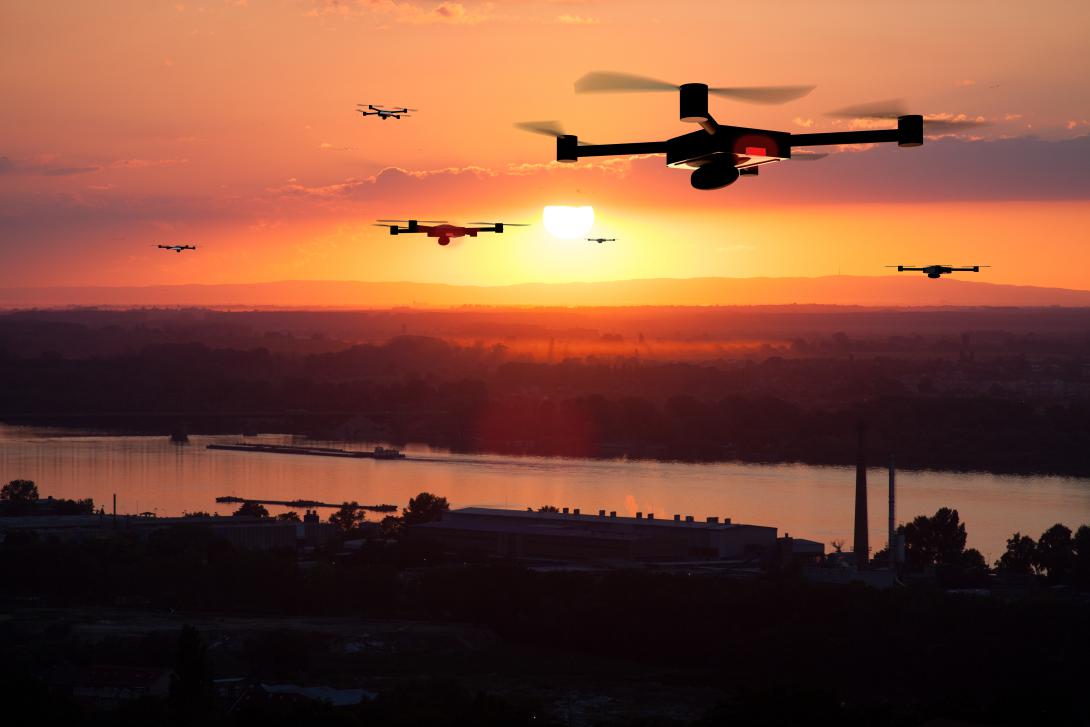NSF Researchers Explore a Wireless World Beyond 5G
A National Science Foundation effort to ensure U.S. national leadership in wireless technologies will not stop at fifth-generation capabilities commonly referred to as 5G.
The extensive program, Platforms for Advanced Wireless Research (PAWR—pronounced power), already has established testing grounds in three states—Salt Lake City, Utah; Raleigh, North Carolina, and New York City. Additionally, the National Science Foundation (NSF) recently released a request for proposals for a rural broadband testing area. The goal is to establish four city-scale testbeds, which NSF officials refer to as platforms. Each platform will ultimately be connected virtually as a shared innovation lab for wireless research.
The testbeds are designed to accelerate the development and commercialization of promising technologies by serving as testing grounds for lab-developed systems. In addition to achieving and maintaining U.S. leadership in wireless technologies, the program is designed to prepare the next-generation workforce for new job opportunities.
The program is overseen by the PAWR Project Office, which is funded by the NSF and run by US Ignite Inc. and Northeastern University. The NSF is providing $50 million in funding, and the consortium is matching that with dollars, equipment, expertise and human resources. Furthermore, the NSF is working with a variety of other agencies, including the Federal Communications Commission, the Defense Advanced Research Projects Agency (DARPA), the National Institute of Standards and Technology, and the National Telecommunications and Information Administration.
The program is part of a broader strategy to support smart cities and communities, and the research is expected to help shape the future of wireless networks.
“We are hoping to understand the building blocks of future generations of wireless communications networks through this program, going beyond 5G and not stopping at 6G, but stretching into other types of wireless networks that we may not even know about yet but that could become essential to humankind. Our platforms are designed to support the emergence of such networks by promoting open and flexible experimentation at all levels—spectrum, device, networks and applications,” says Thyaga Nandagopal, acting deputy assistant director, Directorate of Computer and Information Science and Engineering, NSF. “We are hopeful that this program will help solve the—artificial—spectrum scarcity problem, by helping test more novel ways of using spectrum than we have been doing for the last 100 years.”
He adds that while wireless technologies have come a long way, their full potential has yet to be realized. “Wireless communications have become the principal way by which we use digital technologies today. While wireless networks have become ubiquitous in the last 15 years, their full power has not been unleashed yet. The PAWR platforms will be the vehicle for demonstrating what is possible and will unleash a wave of innovation that will become the bedrock of technology for the next 20 years or more.”
The program so far includes three different platforms: the Platform for Open Wireless Data-driven Experimental Research (POWDER), Salt Lake City; the Cloud Enhanced Open Software Defined Mobile Wireless Testbed for City-Scale Deployment (COSMOS), New York City; and the Aerial Experimentation and Research Platform for Advanced Wireless (AERPAW), Raleigh.
POWDER will deploy more than 400 software-defined radios across the city, and experimenters will use them to build wireless networks. It seeks to create available spectrum anytime and anywhere, offer 100 times improvement in wireless network speeds via advanced antenna technologies, develop bidirectional sharing of spectrum between the government and private licensees, create secure wireless networks resistant to interference and attacks, and develop Internet of Things networks that are energy-efficient and long-lasting. “The vision for the POWDER platform is to enable flexible and agile spectrum sharing in real time in complex real-life settings. This will solve many challenges with the current way we use spectrum that creates an artificial notion of scarcity,” Nandagopal explains.
POWDER explores multiple-input multiple-output technology on a massive scale, extending the capability to hundreds of antenna elements rather than 64 elements, the current state of the art. “The theory behind this is that your speed will increase in direct proportion to the number of antennas. However, each time we double the antennas, the number of mathematical calculations that needs to be done increases fourfold,” Nandagopal offers. “The POWDER system will use 256 antennas, delivering eight times more bandwidth than current 5G networks. There are plans to build a system with 512 antennas, which will double the possible data speeds to 16 times the speed of current 5G networks.”
The architecture for the COSMOS platform focuses on ultra-high bandwidth, low-latency wireless communication tightly coupled with edge cloud computing. The testbed will be deployed in upper Manhattan and will consist of 40-50 advanced software-defined radio nodes along with fiber-optic networks.
Researchers will be able to run experiments remotely on the COSMOS testbed by logging into a web-based portal, which will provide various facilities for experimentation, measurements and data collection. The primary goal is to enable testing in the higher-frequency bands known as millimeter waves, which are above 20 gigahertz. “These bands have the potential to deliver higher speeds without causing widespread interference. In addition, they can be used to develop radar vision, which provides the ability for cars to scan the surroundings, which is cheaper than the LIDARs used today to scan the surroundings,” Nandagopal says. LIDAR is an acronym for technology referred to as either “light detection and ranging” or “light imaging, detection and ranging.”
The most recently-awarded effort, AERPAW, is expected to enable significant research into the wireless communications capabilities necessary for mobility systems such as those involving ground vehicles and autonomous drones, says Erwin Gianchandani, NSF acting assistant director for computer and information science and engineering, in a written announcement. “By enabling experiments that consider three-dimensional, highly mobile, and diverse scenarios, AERPAW will be critically important for enhancing wireless networking capabilities in our communities, and for furthering the development of innovative new applications that will improve civic services and citizen safety,” he adds.
The announcement describes AERPAW as a “first-of-its-kind aerial wireless experimentation platform” meant to accelerate the integration of unmanned aerial systems into the national airspace. It also will enable new advanced wireless features for unmanned aerial platforms, such as flying base stations for rapidly deployable wireless connectivity.
“Unmanned vehicles—both in the air and on the ground—have a great potential to serve as communication amplifiers to increase bandwidths and signal coverage of wireless communication networks,” Nandagopal elaborates. “In addition, these can be used to rapidly deploy a communication network in a place where such networks do not exist.” For example, if a natural disaster or terrorist strike wiped out all cell towers in a particular region, unmanned systems could deploy and stand in as a communications infrastructure. “Current networks are limited in the ability to adjust since they cannot move in any dimension. These mobile nodes can also augment existing cellular networks by acting as relays,” Nandagopal states.
Ground vehicle nodes also could enhance day-to-day communications. “Imagine your car sitting outside your home, receiving a strong signal from the base-station, but you do not get much of a signal in your basement. If your car, or any car in the immediate neighborhood, were to become a relay, you could immediately get better coverage indoors. Given that much of the cellular industry planning focuses on getting effective indoor coverage in residential areas, this is an important problem that has the potential to save time, money and resources for network operators in the long-term,” Nandagopal asserts.
Furthermore, AERPAW could allow first responders to deploy networks wherever needed, saving costs and potentially saving lives. “This is the low-hanging fruit. Some of our earliest investments in research projects dating back to 2014 have demonstrated the power of using rapidly deployable drone-based wireless end-points to augment the comms capabilities for first responders,” Nandagopal says. “This platform will drastically improve it. By having a mobile network, the first responders can carry their advanced network with them, instead of having to rely on a nationwide or regional advanced network.”
The platform might even allow augmented reality to be used in remote locations. Nandagopal describes a scenario in which a technician needs to debug a complex piece of equipment. Augmented reality could allow the technician to work in real time on the equipment while the advanced wireless network delivers additional information, such as virtual catalogues, manuals, tutorials or remote assistance. “The advanced wireless network could be something that the technician turns on in the field by deploying a 6G drone, which flies up, hovers close by, and connects with a very high-bandwidth link to a faraway base station and delivers the content with very little delay.”
AERPAW also could enable vehicle-to-vehicle communications, updating cars on current conditions, even if a fixed roadside infrastructure is not available. “In this case, vehicles need to talk to each other, and then possibly to the cellular base station. Vehicle-to-vehicle communication has lower delays, and hence by enabling experimentation with such technologies, AERPAW can enhance public safety on roads,” Nandagopal suggests.
The next PAWR project will focus on technologies to advance wireless communication in rural areas. The effort aims to deliver fast, low-latency and reliable broadband services to rural users in an efficient and affordable way. Proposals should include creation of a testbed for experimenting with advanced wireless technologies and network architectures—combined with existing technologies—that could transform the cost curve for deploying broadband. Solutions should connect end users over a span of tens of kilometers or miles, while supporting low-cost delivery of data rates higher than anything achievable today.
Overall, the PAWR program already is making progress. The POWDER platform, for instance, is operational with fixed nodes. Mobile nodes will be deployed in the coming months, and the entire system should be operational by March of 2021. In addition, both POWDER and COSMOS are already working with federal agencies and the wireless industry to meet testing needs. “For example, the Defense Advanced Research Projects Agency is going to use the POWDER testbed to take their Spectrum Collaboration Challenge winning technologies and evaluate them in a live environment,” Nandagopal reports. “Industry users are leveraging the development of open-source network software as part of these testbeds and are starting to deploy them in their networks.”
Without going into details, he also hints that the collaboration with DARPA will soon show significant results. “You are going to see a demonstration of some cutting-edge DARPA technologies on the POWDER platform within a few months.”







Comment
All of these 3 projects seem
All of these 3 projects seem viable and they certainly fill a need. There will inevitably be some attack or disaster which wipes out communications. I experienced the 2011 electrical outage in San Diego county (3 million affected). It lasted approximately from 4pm to 4am. It was due to a bad software update. Communications were totally out - no TV, no radio, no phones (although I think landlines were working). What worked for us was a hand cranked emergency radio. The only station we could pick up was a Talk Radio station....which gradually put the picture together that the whole county was in a power outage. It was a total mess. It took one of my son's friends 3 hours just to get out of his parking structure. It was total gridlock. It wasn't until 8pm that the Mayor made an announcement over the Talk Radio station.
The 3 solutions above would have helped in our situation. There are some other considerations that should be kept in mind. Let's say the AERPAW is set up for cellphone communication. In the event of a power outage, the cellphone batteries are going to run down and AERPAW isn't going to be too effective after 24 hours. So you need to think about a survival electric power system as well. Let's say that a back-up electrical grid was connected to all Fire Stations. People could at least go there to recharge their batteries (obviously some sort of priority system would have to be instituted).
The same sort of thing has to be considered for COSMOS and POWDER. You are going to need survivable power for those radios.
In the case of our experience in San Diego, I think the only power that was available was from back-up generators at hospitals. Some people had back-up generators. Some people ran their car engines to just play their radio for information. This illustrates the potential of using cars as a back-up power system for communications. By siphoning fuel from most cars in a neighborhood, you would probably be able to run a car radio in one cars for days.
I think we need to be thinking beyond communications to a survivable communications/electrical system.
Comments